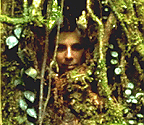
A Journey through the Rainforest
by Sandy Wiseman
Home : Travel : Costa Rica : One Section
A repeated piercing squawk fractured my sleep again, the same intrusive sound that jolted me awake each of the past two days. I knew its source was a bird, near the ground and probably within ten feet of my cabin, but hidden in the dense curtain of leaves beside the trail. Experience also taught that the moment I stepped outside it would turn silent and still. So I turned my thoughts elsewhere.
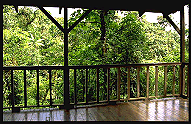 Through the screened window at the head of my bed I could see the orange glow of the sun on the forest canopy across the river. I pulled on my field clothes, still damp, pants caked with mud below the knees, and went down to the deck high overlooking Atelophus creek.
I checked the weather (clear sky, cool, sweatshirt needed) and glanced at the green-fronted lancebill hummingbird nesting against the cabin just under the overhanging roof.
Through the screened window at the head of my bed I could see the orange glow of the sun on the forest canopy across the river. I pulled on my field clothes, still damp, pants caked with mud below the knees, and went down to the deck high overlooking Atelophus creek.
I checked the weather (clear sky, cool, sweatshirt needed) and glanced at the green-fronted lancebill hummingbird nesting against the cabin just under the overhanging roof.
Birds of many kinds were already active in the canopy, especially in two trees to the left of the deck. From high in the treetops, parrots and parakeets were squawking and feeding not just themselves but dozens of other creatures, with the fruit they carelessly dropped and scattered across the forest floor. With my binoculars, I saw more than a dozen other species but could identify only a couple without the field guide left on the stand beside the bed. After a few minutes taking in the air, always pleasant with a mingling of decay and perfume, my mind turned to coffee and breakfast at the
Rara Avis lodge.
Fifteen minutes later, I grabbed my daypack (already stuffed with camera, binoculars, umbrella, waterproof bags, pocket knife, and water bottle), pulled on my black rubber boots, and headed off.
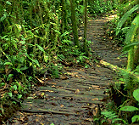
The trail was laid crosswise with narrow logs or planks over which chicken-wire was stapled to improve traction. But moss overgrew the wood and care was needed, especially in the morning when dew created a surface that could be treacherously slick. I walked slowly, pausing every few feet to scan the forest on both sides for birds or animals. I knew well that the odds of seeing something of interest were directly proportional to time spent looking. Most creatures of the forest, especially those active by day, are unobtrusive in appearance, habit, or both.
The morning forest was damp and cool, the sun too low for warmth. Songs I couldn't identify from birds I couldn't see issued sporadically from every direction except directly overhead. The trail descended gradually, parallel to the creek, then opened onto a clearing flanked by the lodge to the right and dining area to the left. The birders, of course, were already active. Binoculars to eyes, field guides clamped under arms, they peered and pointed in silence to newfound species. Other guests headed directly to hot coffee and conversation.
 Suddenly the bushes beside the steps to the dining area rustled and as heads turned, the long nose of a coati (a relative of the raccoon and an opportunist of equal impudence and skill) poked through. This particular animal had only a single eye and had come to depend for its living on the daily handouts of the charitable kitchen staff.
Suddenly the bushes beside the steps to the dining area rustled and as heads turned, the long nose of a coati (a relative of the raccoon and an opportunist of equal impudence and skill) poked through. This particular animal had only a single eye and had come to depend for its living on the daily handouts of the charitable kitchen staff.
Then, sharp at 7:30, platters of scrambled eggs, bacon, fresh papaya, pineapple, cantaloupe, toast, and the obligatory gallo pinto (Costa Rica's own version of fried rice and black beans) were carried from the kitchen to the long table, seating ten on each side. Pitchers of blackberry juice were called for from one end and dutifully passed from the other. Later, breakfast over, the guides detailed the morning's walk to the lodge's guests as I put on my pack and headed into the forest.
 To move at my own pace, I set off alone along Sendero Platanillo, a little-used path that winds gently downhill to the river bordering the Rara Avis reserve. Tree roots and vines crisscrossed the trail like trip wires and I walked with care. There were shallow streams to wade and muddy hollows to cross. And even though it hadn't rained in two days and the higher ground was fairly dry, my pant legs were soon coated with fresh mud. Overhanging trees hid most of the sky leaving the forest in dark shades of green and brown, broken just ahead above the leaf litter by the scarlet flash of a single passionflower.
To move at my own pace, I set off alone along Sendero Platanillo, a little-used path that winds gently downhill to the river bordering the Rara Avis reserve. Tree roots and vines crisscrossed the trail like trip wires and I walked with care. There were shallow streams to wade and muddy hollows to cross. And even though it hadn't rained in two days and the higher ground was fairly dry, my pant legs were soon coated with fresh mud. Overhanging trees hid most of the sky leaving the forest in dark shades of green and brown, broken just ahead above the leaf litter by the scarlet flash of a single passionflower.
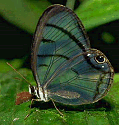 Before I could tuck my camera back into my pack, the amorphous shape of a tiny clear-winged butterfly floated in jerks along the path and came to rest on a frond over the trail. Its transparent wings made it virtually invisible in the forest, reminding me that active searching of branches and leaves was required to detect the creatures hidden around me.
Before I could tuck my camera back into my pack, the amorphous shape of a tiny clear-winged butterfly floated in jerks along the path and came to rest on a frond over the trail. Its transparent wings made it virtually invisible in the forest, reminding me that active searching of branches and leaves was required to detect the creatures hidden around me.
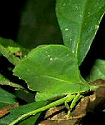
My renewed vigilance was soon rewarded when I spotted a small leaf that seemed to sport legs! This leaf-mimic katydid was a rare find, particularly during the day when these insects remain motionless and so undetected by predators.
The following half hour was uneventful. Then something moved just off the
trail and caught my eye
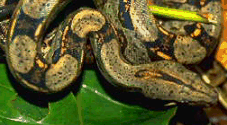 as it slid beneath dead leaves. Suspecting a snake, I took a long stick and from a good distance gingerly moved the litter. Under the leaves, no more than two feet long, had coiled a baby boa constrictor.
as it slid beneath dead leaves. Suspecting a snake, I took a long stick and from a good distance gingerly moved the litter. Under the leaves, no more than two feet long, had coiled a baby boa constrictor.
Seeing any sort of snake is uncommon in a rainforest, and this was the first I spotted in days. Like other animals that rely on camouflage for protection, it remained motionless as long as I didn't disturb it. After a few quick photos, I left it alone.
 A short while later I reached the steep slope over the river, the end of the trail at the boundary of the reserve. Through the trees was the reward for those who walk the full length of the Platanillo trail: a spectacular waterfall pouring into a green canyon. Beyond lay unbroken, undisturbed rainforest.
A short while later I reached the steep slope over the river, the end of the trail at the boundary of the reserve. Through the trees was the reward for those who walk the full length of the Platanillo trail: a spectacular waterfall pouring into a green canyon. Beyond lay unbroken, undisturbed rainforest.
It was now close to eleven and time to return to the lodge for lunch so I turned back. Ahead, bits of leaves like green confetti dotted the ground,
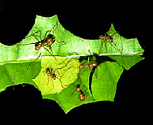 moving along an inch-wide trail leading to a mound of bare earth twenty feet to the right. I was stepping over a never-ending column of ants returning home with crescents of leaves held aloft.
I decided to make a detour. The oval mound, rising three feet above the ground, covered at least a hundred square feet. I had found the nest of millions of leaf-cutter ants.
moving along an inch-wide trail leading to a mound of bare earth twenty feet to the right. I was stepping over a never-ending column of ants returning home with crescents of leaves held aloft.
I decided to make a detour. The oval mound, rising three feet above the ground, covered at least a hundred square feet. I had found the nest of millions of leaf-cutter ants.
Now the air was noticeably warmer, my shirt damp with perspiration, and my thoughts increasingly fixed on a shower and getting into some dry clothing before lunch.
I walked straight back to the cabin. By the time I reached the lodge for lunch, I was renewed. The others were gathered around the steps to the dining room, checking the guidebooks and listing the birds they'd seen or heard on the morning's hike (black-chested hawk, collared trogon, tinamou, chestnut-mandibled toucan, ...). They recalled the troop of howler monkeys they had encountered and laughed about skidding in slopes of mud. Over a typical Costa Rican meal of chicken, salad, vegetables, rice and beans, they talked (in English, Dutch, German, and French) of where they lived, what they did at home, and what brought them to Costa Rica and Rara Avis. Over coffee, while others discussed which trail would be most productive for wildlife, I decided to heed the call of the hammock.
The shrill buzz of cicadas filled the mid-afternoon air. I returned to the cabin and, with a copy of Tropical Nature (Adrian Forsyth and Ken Miyata's superb introduction to neotropical rainforests) in hand, I slid into the hammock. When I awoke an hour later, the sky was clouding over. If I hurried, there was still time enough to walk the two miles to the Rara Avis butterfly farm and return before dark and I gathered my gear and set off down the slope.
I covered not more than fifty feet when I was startled by a rustle in the shrubbery almost at my feet. I froze and saw only a long, almost hairless tail. A moment later, as I backed up, a tamandua (a vested anteater) retreated from the undergrowth, its snout testing the ground for opportunity. It made its way lethargically to a small termite nest in the stump of a fallen tree and began to tear away at it. The tamandua was oblivious to my presence. Only after it heard me shift to reach my camera did it stand erect with nose held high to taste the air.
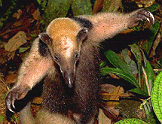 Then, detecting my presence, it spread wide its hooked forepaws as if to invite a hug, in a characteristic defensive posture. Within a minute, concluding I posed no threat, it resumed its foraging, shuffling and sniffing into the forest.
Then, detecting my presence, it spread wide its hooked forepaws as if to invite a hug, in a characteristic defensive posture. Within a minute, concluding I posed no threat, it resumed its foraging, shuffling and sniffing into the forest.
I now thought better of hurrying through the woods and put off until morning the visit to the butterfly project. Here, I would sit for a while and take in my surroundings and whatever happened by. Perhaps after dinner I would put on my headlamp and take a night hike. But right now, the richness of the rainforest was intoxicating enough. With patient observation and quiet thought, it rekindled marvel and wonder. Surely that was a paltry price to pay for feelings so rare.
Sandy Wiseman is a forensic and educational psychologist, conservationist, photographer, and director of Conservation International - Canada. He organizes trips to rainforests for the University of Toronto and enjoys photographing wildlife, particularly rainforest creatures.
Although he grew up in Montreal, Sandy's love for wilderness blossomed in graduate school at Cornell University. He returned to Canada after completing his Ph.D. and now lives in Toronto where he devotes his spare time to biodiversity conservation and planning returns to the tropics.
Text and pictures copyright 1995 Sandy Wiseman.
Related Links
- bicycle Costa Rica- Sue and Ray's adventures while bicycling through Costa Rica, first for our honeymoon, then on return trips (contributed by ray krueger)
- Monteverde's cloud forest area- Monteverde's main web site. Santa Elena Reserve home page, description of all activities in the area,links to Sky Trek, buttefly garden, eco farm, Volcano Arenal, budget hotel, etc. If you got to CR see the cloud forest,volcano and beach! (contributed by pierre jolicoeur)
- Discount Travel & Tours by Irving Darche- National Parks of Costa Rica (contributed by Irving Darche)
- Welcome to Matapalo- An international vacation-school deep in the jungle,but connected to the net,provides homestays in a multi-cultural area.Worth seeing,doing! (contributed by Constantijn De Witte)
Add a comment | Add a link
 Through the screened window at the head of my bed I could see the orange glow of the sun on the forest canopy across the river. I pulled on my field clothes, still damp, pants caked with mud below the knees, and went down to the deck high overlooking Atelophus creek.
I checked the weather (clear sky, cool, sweatshirt needed) and glanced at the green-fronted lancebill hummingbird nesting against the cabin just under the overhanging roof.
Through the screened window at the head of my bed I could see the orange glow of the sun on the forest canopy across the river. I pulled on my field clothes, still damp, pants caked with mud below the knees, and went down to the deck high overlooking Atelophus creek.
I checked the weather (clear sky, cool, sweatshirt needed) and glanced at the green-fronted lancebill hummingbird nesting against the cabin just under the overhanging roof.








